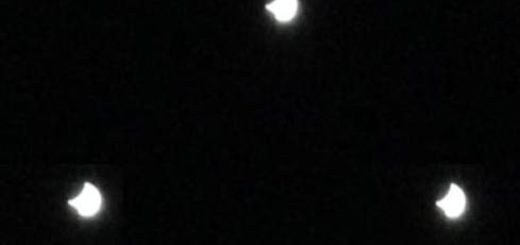Source Of 300,000 Light-Years Long Gas Cloud Finally Identified
A cloud of gas 300,000 light-years long is arching around the Milky Way, shunted away from two dwarf galaxies orbiting our own.
For decades, astronomers have wanted to know which of the two galaxies, the Large and Small Magellanic Clouds, is the source of the gas that has been expelled as the two galaxies gravitationally pull at one another.

An image of the Magellanic Stream with the Leading Arm, a cloud of gas ripped from the Large Magellanic Cloud (LMC) and Small Magellanic Cloud (SMC) system. The quasars used in the current study to analyze the Leading Arm are labeled A-C. Space Telescope Science Institute
Now, astronomers at the University of Wisconsin–Madison worked with colleagues at the Space Telescope Science Institute have analyzed the stream of gas.
By identifying the chemical makeup of the gas, known as the Leading Arm of the Magellanic Stream, the researchers identified one branch as coming from the Small Magellanic Cloud.
The results show that the Large Magellanic Cloud is winning a gravitational tug of war with its smaller partner.
“We still don’t know how the Milky Way has formed,” says Elena D’Onghia, a professor of astronomy at UW–Madison and co-author of the new study. “We have this huge amount of gas sitting around the Milky Way, and we still don’t know its origin. Knowing where it comes from helps us understand how galaxies form, including our Milky Way.”
In the 1970s, the Magellanic Clouds were identified as the source of an enormous stream of matter — the Magellanic Stream, which includes the Leading Arm — that could be seen encircling the disk of the Milky Way.
The Milky Way and the Large and Small Magellanic Clouds (at bottom) pass in the night sky above the Southern African Large Telescope (SALT) in South Africa . PHOTO: JEFF MILLER
The Milky Way and the Large and Small Magellanic Clouds (at bottom) pass in the night sky above the Southern African Large Telescope (SALT) in South Africa . Photo: Jeff Miller
Blair Savage, an emeritus professor of astronomy at UW–Madison, devoted decades to understand the gas complexes around the Milky Way, including the Magellanic Stream.
“There’s been a question: Did the gas come from the Large Magellanic Cloud or the Small Magellanic Cloud? At first glance, it looks like it tracks back to the Large Magellanic Cloud,” explains Andrew Fox of the Space Telescope Science Institute in Baltimore, a former graduate student of Savage’s and the lead author of the study.
“But we’ve approached that question differently, by asking: What is the Leading Arm made of? Does it have the composition of the Large Magellanic Cloud or the composition of the Small Magellanic Cloud?”
The researchers identified four quasars — ultra-bright galactic centers — that lie behind the stream of gas. They then collected ultraviolet light from the quasars as it filtered through the Leading Arm. The next step was to combine the ultraviolet light data with measurements of hydrogen using radio data, which showed an abundance of oxygen and sulfur characteristic of the Small, rather than the Large, Magellanic Cloud.
The similarity in chemical makeup is evidence that the Leading Arm was gravitationally ripped from the Small Magellanic Cloud, likely more than a billion years ago.
“The whole point of this work is to understand what is happening to the Magellanic Clouds as they begin to merge with the Milky Way and how the gas from the clouds mixes with the gas from the Milky Way,” sais Bart Wakker, a senior scientist in the UW–Madison astronomy department.
“And we’re really only in the beginning stages of understanding that process.”



 Creators of mankind
Creators of mankind Description of “Tall white aliens”
Description of “Tall white aliens” Where they came from?
Where they came from? About hostile civilizations
About hostile civilizations The war for the Earth
The war for the Earth “Tall white aliens” about eternal life
“Tall white aliens” about eternal life Video: “Nordic aliens”
Video: “Nordic aliens” Aliens
Aliens Alien encounters
Alien encounters The aliens base
The aliens base UFO
UFO Technology UFO
Technology UFO Underground civilization
Underground civilization Ancient alien artifacts
Ancient alien artifacts Military and UFO
Military and UFO Mysteries and hypotheses
Mysteries and hypotheses Scientific facts
Scientific facts


















